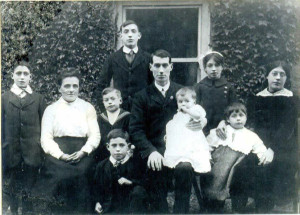| Nationality: |
United Kingdom |
| Rank: |
Private (Signaller). |
| Regiment/Service: |
Royal Inniskilling Fusiliers |
| Unit Text: |
“D” Coy. 9th Bn. Also noted as 2nd Bn. |
| Age: |
21 |
| Born: |
Castledawson 1897. |
| Enlisted: |
Cookstown. |
| Residence: |
Castledawson. |
| Date of Death: |
19/09/1918 |
| Service No: |
27419 |
| Casualty Type: |
Commonwealth War Dead. DOW. |
| Grave/Memorial Ref: |
IV. A. 1. |
| Cemetery: |
La Kreule Military Cemetery, Hazebrouck, Nord, France. |
| Additional information: |
Son of Joseph and Elizabeth McCracken, of Hillhead, Castledawson, Co. Londonderry. |
|
Prior to George joining up he worked with his father Joseph at Clark’s of Castledawson. He followed the footsteps of his father Joseph who had previously seen action in the Boer War. Young George also joined the Inniskillings in 1914 at the age of 17. He received his initial training at windswept Finner Camp, Co Donegal and then on to Randalstown Camp before embarking to Seaford Camp in Sussex and from thence to France. George survived many of the major battles including The Somme before being killed in action by a shell burst at the attack on Dadizeele on the 19th September exactly 53 days before the Armistice was signed. He is buried at Le Kreule Military Cemetery Hazebrouk. This is a small cemetery in Northern France. He is commemorated on the UVF memorial in Castledawson War Memorial Hall and on the cenotaph in the Bell Park. He was posthumously awarded the British Medal and Victory Medal. His name has been carried on by his nephew and great nephew. |
|
 |
|
A photograph of The McCracken family, George is standing behind his father. |
|
 |
|
THE DEAD MAN'S PENNY |
|
It was decided during World War One that all next of kin of service personnel who lost their lives as a result of the war would be presented with a memorial plaque and commemorative scroll from the King and country. |
|
The plaques were cast in bronze and were 4 3/4-inch (12cm) in diameter. On the plaque itself no rank was recorded as the intention was to show equality in their sacrifice. |
|
The medallions display Britannia with trident offering a wreath with the British lion at her feet, together with the words 'HE DIED FOR FREEDOM AND HONOUR'. The initials 'ECP', for the designer Edward Carter Preston appear above the lion's right forepaw. The name of the dead soldier appears within a raised rectangle. There are different numbers appearing on the pieces – it is assumed that this identified the mold number or the foundry which cast the piece. |
|
They were distributed to the families of the war dead (908,371 died in WWI) who undoubtedly kept these in their family until perhaps the third or later generation. The commemorative Scroll (see George Gallagher) was sent at the same time. |
|
The troops referred to the medallions as "The Dead Man's Penny". The plaque, unlike the other mementoes, which represent bravery and honour, the heavy plaque made from gun metal represents loss. It was even seen by some as an insult. The plaque was meant as a token of gratitude for the sacrifice made. But the plaques weren't appreciated by everyone because they resembled a penny. It made it seem as though the government saw a soldier's life as only worth a penny. Some families even returned the plaques to the king. |
|
These are not rare items. They are common as one was made for every military person who died in World War I. It is properly called a medallion even though it is uniface. They were made in 1919/20. Interesting, they used an "insert die" to add the name in raised lettering of the military person who died in service. Medal manufacturers call this technology "insert dies" as an individual die (that fits in a cavity in the base die) has to be made for every piece made to effect the raised lettering of the names. |
|
Notification of Death by Telegram, In the case of death the next of kin was notified by an urgent (pink) telegram. A telegram was a telegraphic message sent from one Post Office to another and then written or typed onto a flimsy sheet of paper, enclosed in an envelope and delivered by a boy on a bicycle. The sight of the Telegram Boy approaching was feared and hated by anyone with a relative on active service. It is possible that this plaque was one of those manufactured by Messers Wright and Sons, of Edgeware, Middlesex, at a cost of 13s 6d each, although other makers are thought to have existed. |

